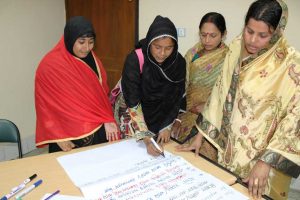STEP 3: ADAPTIVE CAPACITY ANALYSIS
Objective: To look in more detail at the solutions discussed during the impact chain exercise and think about what is needed to successfully implement the proposed activities.
Output: This activity produces 2-4 intervention plans which explain the solution ideas developed in step 2 in more detail.
At this stage, we are trying to encourage a shift in thinking. Instead of focusing on all the risks and negative consequences, we now consider how to address them.
DAY 2 TASK – PART 2
Time: 2.5 Hours
- This activity should be done in groups (4-5 people). Given time constraints, it is often wise to help the groups decide on one or two solutions from their impact chain exercise to focus on.
- Facilitators should then ask the groups to develop their selected idea(s) using the five key characteristics outlined in the ACCRA Local Adaptive Capacity Framework to make sure plans are comprehensive and viable (see below). This involves taking one of the ideas from the Impact Chain exercise and developing it in more detail whilst thinking about each of the 5 categories listed below.
The ACCRA Local Adaptive Capacity Framework Identifies five key characteristics of adaptive capacity:

Asset base (access to)
What would you need to implement the idea? This includes anything you would need to buy or install e.g. instigating an early-warning system would require assets like weather-monitoring software and communication devices such as warning bells or megaphones.
Institutions and entitlements
Who do you need to consult and/or work with for the idea to be accepted? This could be customary committees, agricultural extension officers or religious bodies. It is important consider gender and power imbalances and ensure that your proposals support equal access to information and services for all.
Knowledge and information
What do you need to know in order to make your idea successful? For example, if you want to use solar power you need the technology and expertise to extract, convert and use the energy reserves. Remember to consider how you will disseminate the information, since information is only useful if it can be accessed by those who need it.
Innovation
Learning to adapt is a continuous process. Consider how to do things differently; try new technologies or pilot alternative ideas to help generate new knowledge. We need to constantly challenge ourselves to come up with fresh ideas and take calculated risks in the search for alternative answers.
Flexible, forward-looking decision making and governance
As risks change, escalate and become harder to predict we need to become much more flexibly and agile in our responses. Think about how to monitor situations and encourage interventions to be designed in a way that can respond to changing circumstances in the future e.g. better scenario planning, budget flexibility and/or variable milestones in logframes. This flexibility to change what we do and how we do it needs to be built into programmes at the design phase, and supported by donor contracts and governance processes if we are to effectively support adaptive capacity and resilient development.

